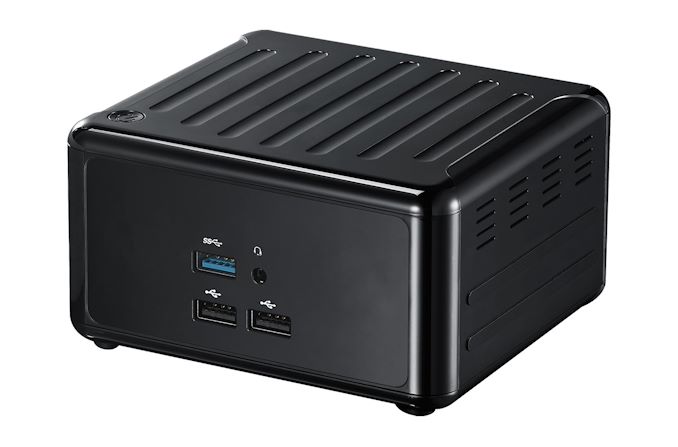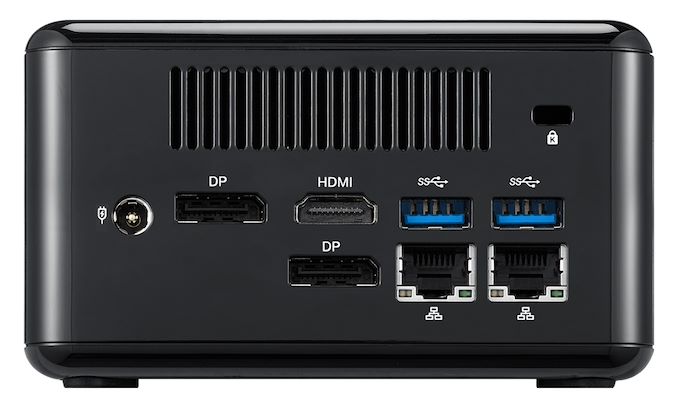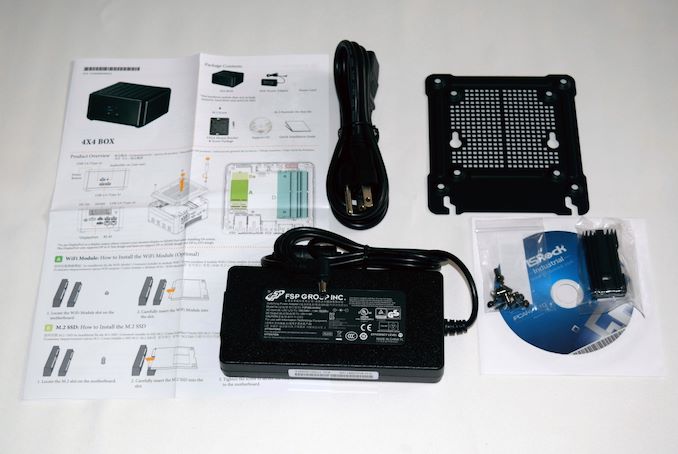ASRock Industrial 4X4 BOX-V1000M Ryzen Mini-PC Review: Finding Zen In The Small Things
by Ganesh T S on September 28, 2020 8:00 AM EST- Posted in
- Systems
- AMD
- NUC
- UCFF
- Ryzen
- Ryzen Embedded
- ASRock Industrial

The miniaturization trend triggered by the ultra-compact form factor NUCs from Intel has emerged as a key driver in the growth of the PC market. Processor power efficiency is of paramount importance in this space, and AMD had been caught napping when the NUCs began to take flight. The introduction of the Zen microarchitecture in the Ryzen processors has scripted a remarkable turnaround for AMD. With leading core counts, the Ryzen processors have taken the HEDT market by storm. UCFF PC manufacturers, however, opted to play the wait and watch game, and it took a while before the embedded SoC versions of the first-generation Ryzens started appearing in the PC market. Last year, ASRock Industrial introduced one of the first Ryzen UCFF systems in the form of the 4X4 BOX-V1000M. This review attempts to figure out how the unit fares against the entrenched incumbents.
Introduction and Product Impressions
Small form-factor (SFF) PCs and gaming systems have represented the bulk of the growing segment in the PC market over the last few years. Intel's NUC line-up has enjoyed unprecedented success. Despite the introduction of notebook processors using the first-generation Zen microarchitecture, AMD's power efficiency was not good enough for vendors (and even AMD themselves) to make a dent in Intel's success in the NUC space. The equation changed slightly with the launch of the AMD Ryzen Embedded processors in early 2018. Starting as a trickle with a mini-STX board from with Sapphire, the uptake of the Ryzen Embedded series became a veritable deluge late last year with UCFF systems from ASRock Industrial, EEPD, OnLogic, and SimplyNUC.
ASRock Industrial has been at the forefront of AMD-based UCFF PCs, being one of the first to bring out UCFF systems based on the Ryzen Embedded APUs in mid-2019. In fact, their boards have been adopted by vendors such as OnLogic in their ML100G-40 systems. The company offers three different 4X4 BOX configurations - the dual-core R1505G and R1606G variants in the R1000M and R1000V, and the flagship quad-core V1605B-based V1000M. The last of the three is the one we are looking at today.
The 4X4 BOX-V1000M is ASRock Industrial's flagship AMD Ryzen Embedded offering with a 104mm x 102mm main-board housed in a 110mm x 118.5mm x 67.3mm plastic chassis. The system matches the Intel NUCs in the footprint department. The board comes with a soldered processor - the V1605B belonging to the AMD Ryzen Embedded V-Series. It is a quad-core processor with SMT enabled (4C/8T). It can operate with a TDP configurable between 12W and 25W.
Switching to peripherals and networking, the board's WLAN component is M.2 card - the Intel AC3168. The system is otherwise barebones, providing with the flexibility to choose their own storage device and RAM. For best performance, a PCIe 3.0 x4 NVMe SSD can be used, and DDR4-2400 SODIMMs are supported. However, it must be noted that the system does NOT support M.2 2280 SSDs. Only M.2 2242 and 2260 Key M SSDs (both SATA and NVMe) are supported. We installed a Transcend MTS600 SATA SSD (one of the few M.2 2260 SSDs that we had access to during our testing process) along with vanilla DDR4 SODIMMs from the Team Group brand.
The specifications of our ASRock 4X4 BOX-V1000M review configuration are summarized in the table below.
| ASRock Industrial 4X4 BOX-V1000M Specifications | |
| Processor | AMD Ryzen Embedded V1605B Ryzen Embedded V-Series, 4C/8T, 2.0 (3.6) GHz 2MB L2 + 4MB L3, 14nm, 12-25W TDP |
| Memory | Team Group TEAMGROUP-SD4-2666 DDR4 SODIMM 16-16-16-39 @ 2400 MHz 2x8 GB |
| Graphics | AMD Radeon Vega 8 Graphics |
| Disk Drive(s) | Transcend MTS600 TS256GMTS600 (256 GB; M.2 Type 2260 SATA III; Micron 20nm MLC) (Silicon Motion SM2246EN Controller) |
| Networking | Intel Dual Band Wireless-AC 3168 (1x1 802.11ac - 433 Mbps) 2x Realtek RTL8111G Gigabit Ethernet Controller |
| Audio | 3.5mm Headphone Jack Capable of 5.1/7.1 digital output with HD audio bitstreaming (HDMI) |
| Miscellaneous I/O Ports | 2x USB 2.0 3x USB 3.2 Gen 2 Type-A |
| Operating System | Retail unit is barebones, but we installed Windows 10 Enterprise x64 (1909) |
| Pricing (As configured) | $390 ( $561 ) |
| Full Specifications | ASRock Industrial 4X4 BOX-V1000M Specifications |
The ASRock Industrial 4X4 BOX-V1000M kit doesn't come with any pre-installed OS, but does come with a CD containing the drivers. In any case, we ended up installing the latest drivers downloaded off the product support page. In addition to the main unit, the other components of the package include a 96 W (12V @ 8A) adapter, a US power cord, a VESA mount (along with the necessary screws), a M.2 SSD heat-sink, a driver CD, user's manual and a quick-start guide.
The gallery below takes us around the hardware in the main unit.
In the table below, we have an overview of the various systems that we are comparing the ASRock 4X4 BOX-V1000M against. Note that they may not belong to the same market segment. The relevant configuration details of the machines are provided so that readers have an understanding of why some benchmark numbers are skewed for or against the ASRock 4X4 BOX-V1000M when we come to those sections.
| Comparative PC Configurations | ||
| Aspect | ASRock 4X4 BOX-V1000M | |
| CPU | AMD Ryzen Embedded V1605B | AMD Ryzen Embedded V1605B |
| GPU | AMD Radeon Vega 8 Graphics | AMD Radeon Vega 8 Graphics |
| RAM | Team Group TEAMGROUP-SD4-2666 DDR4 SODIMM 16-16-16-39 @ 2400 MHz 2x8 GB |
Team Group TEAMGROUP-SD4-2666 DDR4 SODIMM 16-16-16-39 @ 2400 MHz 2x8 GB |
| Storage | Transcend MTS600 TS256GMTS600 (256 GB; M.2 Type 2260 SATA III; Micron 20nm MLC) (Silicon Motion SM2246EN Controller) |
Transcend MTS600 TS256GMTS600 (256 GB; M.2 Type 2260 SATA III; Micron 20nm MLC) (Silicon Motion SM2246EN Controller) |
| Wi-Fi | Intel Dual Band Wireless-AC 3168 (1x1 802.11ac - 433 Mbps) |
Intel Dual Band Wireless-AC 3168 (1x1 802.11ac - 433 Mbps) |
| Price (in USD, when built) | $390 (barebones) $561 (as configured) |
$390 (barebones) $561 (as configured) |


















37 Comments
View All Comments
hallstein - Monday, September 28, 2020 - link
I just want to say how much I appreciate the title of this article. Great work.deil - Monday, September 28, 2020 - link
I will also endorse. Pure perfection. Try doing it with 1185g7, even intel did not try.AMDSuperFan - Monday, September 28, 2020 - link
This does not look like a good product for AMD fans. I am very concerned. Where are the products that can compete against someone? $560 and it doesn't even have a battery?DiHydro - Monday, September 28, 2020 - link
This is not a consumer product. it is for industrial applications were longevity and support are more important than initial price.PeterEvans - Monday, September 28, 2020 - link
Did you have the idea that industrial applications should cost more for longevity? I actuality it is the exact opposite.Spunjji - Tuesday, September 29, 2020 - link
Re: the only factual part of your post, it's only about $100 more than the near-useless Atom-based "June Canyon" NUC, $40 more than the Coffee Lake DeskMini and nearly $200 less than the Comet Lake "Frost Canyon" NUC - and if you need any GPU power there's no contest between them. But sure, please continue to make disingenuous shitposts in order to feed the thrashing mess of worms inside your brain.Ryan Smith - Tuesday, September 29, 2020 - link
Thanks! We've reviewed a lot of NUCs over the years, including AMD ones. So it's an interesting challenge to try to come up with unique titles.tygrus - Monday, September 28, 2020 - link
It's a pity the tech is 2 yrs old (Zen 14nm).What about:
4700G
4900HS
4800U
AMD moving slowly to update all product categories but OEM'S are moving even slower. Who or what are holding them back? Does Intel incentives & previous market dominance delay OEM's releasing AMD products or does AMD have some blame?
5080 - Monday, September 28, 2020 - link
They do offer this unit with a 4800U, see my comment below.DiHydro - Monday, September 28, 2020 - link
This is an industrial mini-PC. Usually used for visual inspection systems, or running GUI controls for machines. They wouldn't need a whole lot of processing power, and would prefer a fully vetted and reliable system (shame about the GPU drivers). That being said, the Ryzen 4000 series is much more attractive for home and office use in the NUC space.